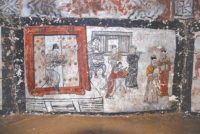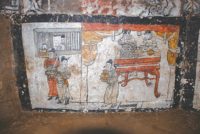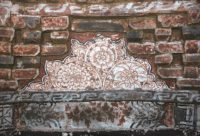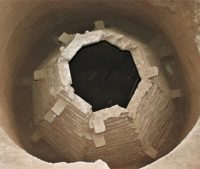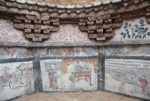 Archaeologists have unearthed an octagonal tomb from the 14th century with murals in excellent condition in Yangquan, east central China. Seven of the eight walls of the tomb are painted with murals while the eighth is taken up by the entrance. There were no human remains found inside, nor were there any grave goods that might identify who was buried there. One of the murals, however, depicts a husband and wife who are believed to have been the tomb’s occupants.
Archaeologists have unearthed an octagonal tomb from the 14th century with murals in excellent condition in Yangquan, east central China. Seven of the eight walls of the tomb are painted with murals while the eighth is taken up by the entrance. There were no human remains found inside, nor were there any grave goods that might identify who was buried there. One of the murals, however, depicts a husband and wife who are believed to have been the tomb’s occupants.
Some of the murals show scenes of life in Mongol-ruled China. These include a band of musicians playing songs, tea being prepared, and horses and camels transporting people and goods, according to the paper.
Some of the people in the murals are shown wearing Mongol, rather than Chinese, fashion styles, the archaeologists noted. For instance, in one mural, a camel is being led by a man who “is wearing a soft hat with four edges, which was the traditional hat of northern nomadic tribes from ancient times,” the archaeologists wrote in the journal article.
“Mongol rulers issued a dress code in 1314 for racial segregation: Han Chinese officials maintained the round-collar shirts and folded hats, and the Mongolian officials wore clothes like long jackets and soft hats with four edges,” they wrote.
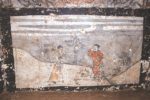 Two of the murals illustrated famous stories of filial piety, an important ethical precept in Confucianism of respect, care and deep empathic feeling for parents, elders and ancestors. These kinds of tales were collected in literary anthologies like The Twenty-four Filial Exemplars. One of the murals depicts one of those 24 examples, the story of Guo Ju who decided to bury his own son alive so that their meager food supply would be sufficient to feed his mother. Guo Ju’s son was spared a terrible death when the father discovered a gold treasure in the hole he was digging for the grave.
Two of the murals illustrated famous stories of filial piety, an important ethical precept in Confucianism of respect, care and deep empathic feeling for parents, elders and ancestors. These kinds of tales were collected in literary anthologies like The Twenty-four Filial Exemplars. One of the murals depicts one of those 24 examples, the story of Guo Ju who decided to bury his own son alive so that their meager food supply would be sufficient to feed his mother. Guo Ju’s son was spared a terrible death when the father discovered a gold treasure in the hole he was digging for the grave.
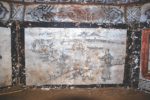 The other filial piety-themed mural in the tomb takes the opposite approach to the same concept. Yuan Jue is the young son of a poverty-stricken family whose father decides to sacrifice Jue’s grandfather so that the rest of them will have enough food to survive a famine. Jue protests his father’s plan to leave his own father to die in the wilderness, insisting that should he go through with this cruel abandonment, Jue will do the same to him when the time comes. The father backs down and all of the family manages to pull through the famine.
The other filial piety-themed mural in the tomb takes the opposite approach to the same concept. Yuan Jue is the young son of a poverty-stricken family whose father decides to sacrifice Jue’s grandfather so that the rest of them will have enough food to survive a famine. Jue protests his father’s plan to leave his own father to die in the wilderness, insisting that should he go through with this cruel abandonment, Jue will do the same to him when the time comes. The father backs down and all of the family manages to pull through the famine.
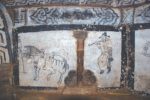 The paintings are in very fine condition, with only architectural interruptions like a massive standing lamp built in to one of the walls. The pyramidal roof, painted with stars in the interior, has also made it from the Mongol era to the present in excellent fettle.
The paintings are in very fine condition, with only architectural interruptions like a massive standing lamp built in to one of the walls. The pyramidal roof, painted with stars in the interior, has also made it from the Mongol era to the present in excellent fettle.
The tomb was first discovered in 2012 and published in Chinese four years later. That 2016 article has now been translated into English and published in the journal Chinese Cultural Relics.
